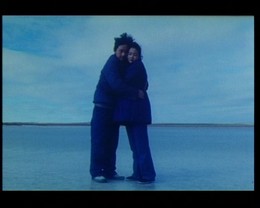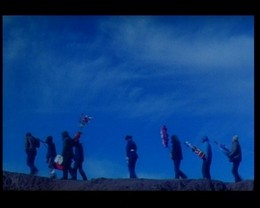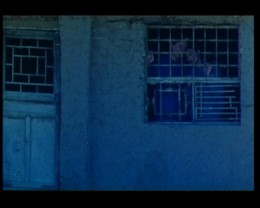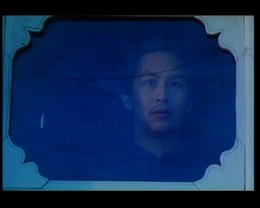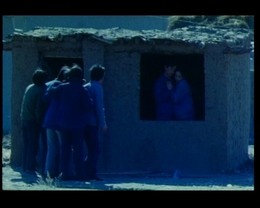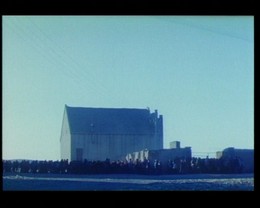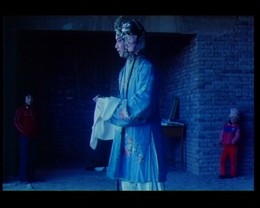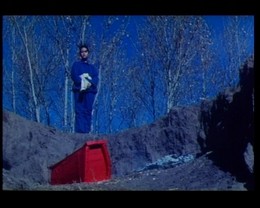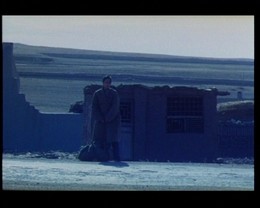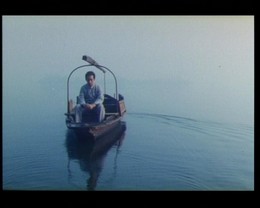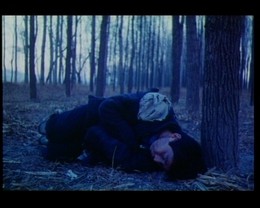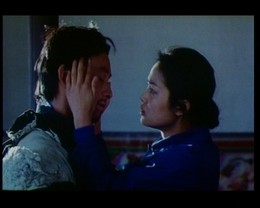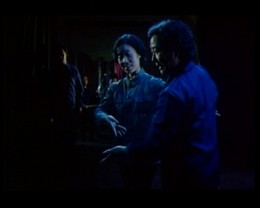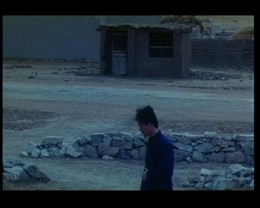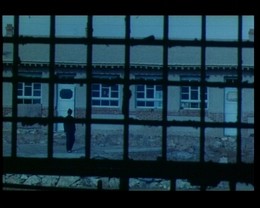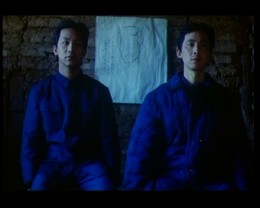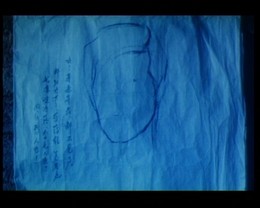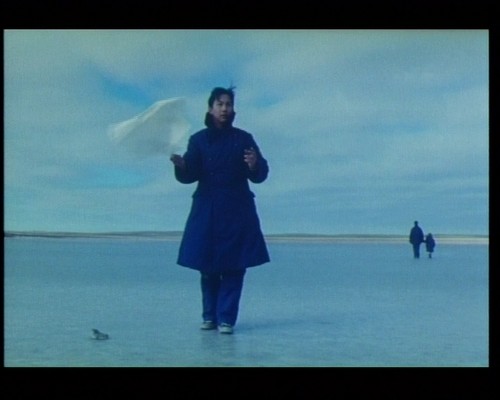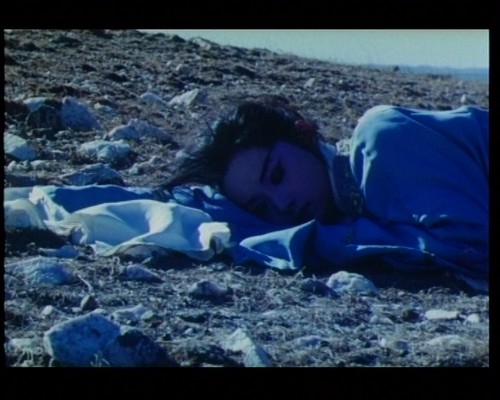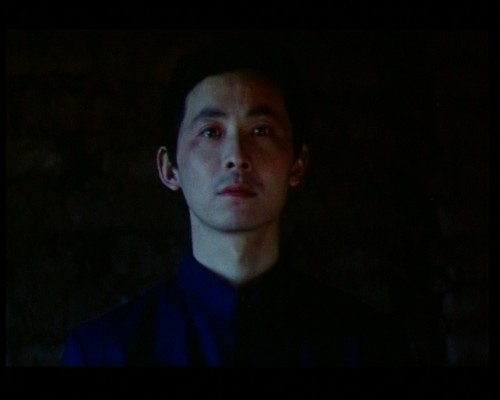Lost spring 1990, 89 minutes
A film by Alain Mazars
Produced by N.T Binh
Selected at LA QUINZAINE DES REALISATEURS of Cannes Film Festival 1990.
Youth Award (prix de la jeunesse) at Cannes Film Festival
Special Jury Award at Florence Film Festival
Montréal Award at Montréal Film Festival
"Léonard de Vinci 1989 Award" of Ministry of Foreign Affairs.
Selected at many film festivals : Florence, Toronto, Singapour, Istanbul, Chicago, Tokyo, Hong Kong, Jerusalem, Mannheim, Gand...
On general release in 1990, in France and abroad (Pays Bas, Canada, Belgique...).
Music : Olivier Hutman.
Synopsis
Yen, an ex singer exiled to Mongolia, falls in love with Ling Ling, a young woman of great beauty. He marries her but discovers that she hides a secret. A story of wild love, shot in China and in Chinese, by a French director.
Press releases
TELERAMA. 29 november 1990.
It's one thing to know China very well, and another to shoot a whole movie in Chinese! But that's what Alain Mazars did. A story of wild love, filmed with great delicacy. A movie as beautiful and subtle as an engraving.
The movie is set in China, during the Cultural Revolution. Yen, an opera singer, is arrested after telling his director what he thought of him. He escapes prison through dreams, imagining scenes from his favorite opera, THE PAVILION OF PEONIES, that he has always wanted to direct. The leading lady of this opera deeply believes that first love, the only love, the true one, survives death, and Yen firmly shares that belief.
As he is freed from jail, he finds himself alone in the middle of nowhere in Mongolia.He marries Ling Ling, a pretty Chinese girl who is sad, and who always seems to be lost in the past. This past suddenly comes back in the form of an old childhood friend of hers, who is still in love with her. Since Ling Ling loves him back, Yen accepts the situation and simply crosses the street, fading away.
Everything in this first feature-length movie by Alain Mazars, lives up to this willingness to give up the person you love..
The characters are noble, pure, and delicate. They almost move in slow motion in stunning still frames representing the theatrical world in which the hero of the movie lives.
Alain Mazars is a master at filming the moment when the apparent distance between people disappears: In a flash-back we see Ling Ling separated from her childhood friend. But the lovers have learned to be together in spirit, at very specific times known only to them. And when her husband looks at Ling Ling through the window, from the other side of the street, we feel by the intensity of his gaze that for him, she's still here.
To express all those feelings to their full measure, Alain Mazars uses mostly still frames, but not only.
Right when you think the style of the movie is very contemplative, all of a sudden the camera moves in a very chaotic way: We leave Yen's vision (the poet), to enter the story of his wife's friend.
Same thing when the characters seem to be still: A crowd of children appears on screen, running to see the hero play parts of his beloved play, THE PAVILION OF PEONIES.
Yen is on stage, dressed as a woman. It's the most mysterious sequence of the movie, and the most confusing for a Western audience, which is not accustomed to this art form, a mix of dance and magic ceremony. What happens at this point between Yen and Ling Ling, seated with her friend in the audience, is invisible.
Faced with this character who sings his desire to fall asleep and join his beloved in his dream, the young woman is distraught and understands that the love of her husband is still alive. On the other side, Yen, through his art, totally transcends this love. The opera and his own life are one. He seems to have gone to another place, convinced that his wife will join him sooner or later.
With distance and restraint, Alain Mazars manages to grasp those very subtle changes in the love story. LOST SRING is like a long flash back. Right from the beginning, Yen shares the story of his life, as he walks slowly by a lake, in front of a landscape which looks like an engraving.
Several times during the movie, you feel like you're falling into a dream world. "Who knows,
said Pascal, if half of our lifetime, when we think we are awake, we are actually in another kind of sleep and wake up when we think we are falling asleep? Bernard Génin
LE MONDE. 29 november 1990.
Mazars knows and loves China, and that's where he shot LOST SPRING.
Maybe you remember a strange and beautiful movie, from the fall of 1987 : BEYOND THE MEMORY, shot in China by Alain Mazars. He worked in China in 1978/79 and, fascinated by the country and its culture, he went back there several times to shoot movies. BEYOND THE MEMORY was the story of an opera singer who was separated from his wife during the Cultural Revolution.
Seven years later, he is back in his village, examining the faces of the children, hoping to recognize the child of the couple that he never saw. The journey was a symbolic one, and the aesthetics of the movie were fascinating.
LOST SPRING was shot with a small budget in October and November 1988, after being authorized by the Chinese government. It's also the story of an Chinese opera singer who is sent to jail at the beginning of the Cultural Revolution. In jail, Yen Yue Jun rewrites his favorite opera, THE PAVILION OF PEONIES. Once he is released, he becomes a truck driver, and marries Ling Ling. This part of the story is quickly told, because the realistic topic is a romantic narrative (just like in BEYOND THE MEMORY): LING LING is in love since childhood with a man named Feng Feng who manages to find her again (we see that story unfold through an amazing flash back reminiscent of those of PETER IBBETSON). Heartbroken, Yen Yue Jun cannot compete with this burning love, stronger that separation and death. He expresses his pain through the presentation in his village of his beloved opera, THE PAVILION OF PEONIES. This opera reflects the world of Alain Mazars, with stories of love and dreams, through a musical and artistic genre very different from Western opera. The movie is almost entirely shot in dreamlike blue colors, a reminder of the Chinese clothes of that time. The characters are often isolated in empty spaces or shot in still frame. Alain Mazars now has mastered his style, rigorous and modest. By using Chinese opera, he creates a true romanticism and conveys emotion through his aesthetics Jacques Siclier
L'EVENEMENT DU JEUDI. 29 november 1990.
In 1966, during the Cultural Revolution, an opera singer is accused of being in the opposition and spends years in prison and reeducation camps before becoming a truck driver. He manages to interpret and present again the opera called THE PAVILION OF PEONIES in his small village. This opera represents for him the moment when his life stopped. But the opera and his real life will become one when he loses the woman he loves. This first movie was shot in China in heroic conditions, and reminds us of OZU. It is an exemplary melodrama, with poetic and very delicate frames. There is a secret beauty that shines through. Dominique Rabourdin
LE CANARD ENCHAINE. 29 november 1990.
Quick glances, fingers that barely touch each other, and silent love screams shine in this modern love story of a couple and their journey between Beijing and Mongolia. This porcelain masterpiece is more instructive than a documentary and more moving that a melodrama. F.P.
L'EXPRESS. 29 november 1990.
Alain Mazars is very bold, as you can see from the topic of his first feature lenght movie. It's a modern and dreamlike melodrama based on a Chinese opera. LOST SRING is uniquely beautiful, a welcome change among fast paced movies. Mazars glorifies the power of desire and love , two things the Cultural Revolution in China wants to deny. The magic comes from the total escape, the difference between time periods, the dream and the reality.
Mazars is very ambitious and is mixing the story of the hero of THE PAVILION OF PEONIES, who represents Chinese romanticism, and the real life drama of Yen. A blue light creates a dreamlike atmosphere, and the aesthetics convey the emotion. Mazars shoots his actors in a very sensual way. This very low budget movie whose shooting was very difficult ,is a one of a kind intense gem, opening the doors of imagination. Dominique de Saint Pern
LIBERATION. 1er december 1990.
Alain Mazars is a young risk taker. A few years ago, after Mao's death and after learning Chinese, he went to work in China as a volunteer teacher. He fell in love with the country even though he was against the political regime, and shot five medium-length features there, including BEYOND THE MEMORY.
LOST SPRING opens with very cold blue images, and Mazars recreates a suffocating atmosphere in a bleak winter light. When he tells the story of the two lovers who met as children, it looks like a nice melodrama. Yen, the hero, overcomes his sadness by working on his favorite opera, and through this we see how well Mazars knows Chinese romanticism and culture (the real one, still alive under communism). He also chooses to put some distance between his camera and the violent feelings on display. The movie was shot before the events leading to the uprising of the students in Beijing and their defeat, another lost spring. Edouard Waintrop
FIGAROSCOPE. 29 november 1990.
... a beautiful topic, shot with the perfect distance, knowledge and sophistication, and with no exaggerated drama, in nostalgic blue frames. The bar is set very high, at all levels, which is quite an accomplishment when you shoot so far from home. Françoise Maupin
L'HUMANITE. 30 november 1990.
An homage from a French director to the Chinese culture. Mazars tells the story of a heartbroken man with the delicacy of a true Chinese and he is strangely convincing. Claude Sartirano
FRANCE SOIR. 29 november 1990.
Mazars managed to overcome all the administrative hurdles and shoot a movie denouncing the abuse of a dictatorship. A real accomplishment.
LA CROIX. 29 november 1990.
Alain Mazars is a master at filming emotions. The singularity of his movies is that the aesthetics are as important as the story itself, and he is always trying to create that perfect balance. The viewer's imagination is nourished by a singular and unusual editing process with no visual shocks, by elaborate frames and by the original soundtrack. In the same way one can create poetry by the way one puts words together, the pictures here are illustrating the feelings in a very subtle way, but without explaining them, which leaves room for a lot of mystery..
LOST SPRING (which won the "Prix de la Jeunesse" at Cannes and the "Prix de la Première Oeuvre" at Montreal) is the first feature-length movie after several medium length ones that remained rather unsung, such as BEYOND THE MEMORY.
Shot with only Chinese actors, this movie is a centered around the concept of being in love and what it means. The natural landscape, with all the trees perfectly aligned, is reminiscent of a theater stage. In the final scenes, the dialogue is covered by the noise of the wind. With only the intensity of the pictures, Mazars is able to create a painful intimacy with the feelings of his characters. Philippe Rouyer
LE FIGARO. 22 may 1990.
Selected for LA QUINZAINE DES REALISATEURS, LOST SPRING is a very successful French and Chinese combination, allowing us access to the secret gardens all the characters have inside of them. Alexandre Bourmeyster
CINEMA 90.
Alain Mazars directed several medium length features that won prizes in festivals in Belfort and Hyères. We give to this movie the CINEMA 90 award for the cinematography, for the music by Olivier Hutman, and for a perfectly mastered movie. Gérard Pétillat
L'ANNEE DU CINEMA. 1991.
Its a very mysterious movie with a script full of drama and romance. many stories intertwined, just like the fate of the characters. Alain Mazars directed this movie with a lot of restraint and purity, and the magic happens when the story and the aesthetics become one. LOST SPRING is a fascinating movie.
POSITIF. july 1990.
This movie is a combination of a lot of aesthetic research and the atmosphere of certain American thrillers, such as OUT OF THE PAST by Jacques Tourneur (who talks about the mark left on those who experienced intense drama in their lives). LOST SPRING tells two stories in flashback.This is a very complex movie in three parts, about politics but mostly about art and love.
The relationships between the characters are constantly enriched by images of the opera THE PAVILION OF PEONIES, whose story enhances the emotional atmosphere of the movie, even though the story of the opera is not the same as the story of the movie. In the last part of the movie, its the opera that is enriched by images of the movie.
With the incredible actors and an amazing soundtrack by Olivier Hutman, we have not only a musical structure but also a a whole aesthetic world, for example in the way Alain Mazars treats color. You can see that he takes care of every detail. He is a control freak but never at the expense of emotion, and thats why the movie received the award from the youth jury. Michel Ciment
POSITIF. november 1990.
Because of its structure and also because of its exceptional visual quality, LOST SPRING is a movie that deserves to be seen more than once. You will be fascinated by the pace of the movie and the way it transports you to another dimension. The importance of the Chinese opera KUN QU is crucial because it gives a magical dimension to the movie. Just like in some movies by Minelli or Powell (YOLANDA AND THE THIEF, THE RED SLIPPERS), the real world and the dream world are intertwined. Pascal Pernod
LA REVUE DU CINEMA. november 1990.
The work of Alain Mazars is becoming more and more structured, the script gives a lot of freedom to the actors, and a lot of attention is given to the light, making the images even more stunning. Jacqueline Nacache
LES ECHOS. 30 november 1990.
Chosen at Cannes for the LA QUINZAINE DES REALISATEURS, this movie will be very interesting for those who love to discover new horizons, and new cultures. Its a very beautiful, touching and accessible movie, telling a very simple story. The shooting was very difficult, but the result, visually (the images of Mongolia), and in terms of intensity, is stunning and hard to forget. Annie Copperman
LES FICHES DU CINEMA.
The very personal work of an director who reveals his full measure.
Pictures
